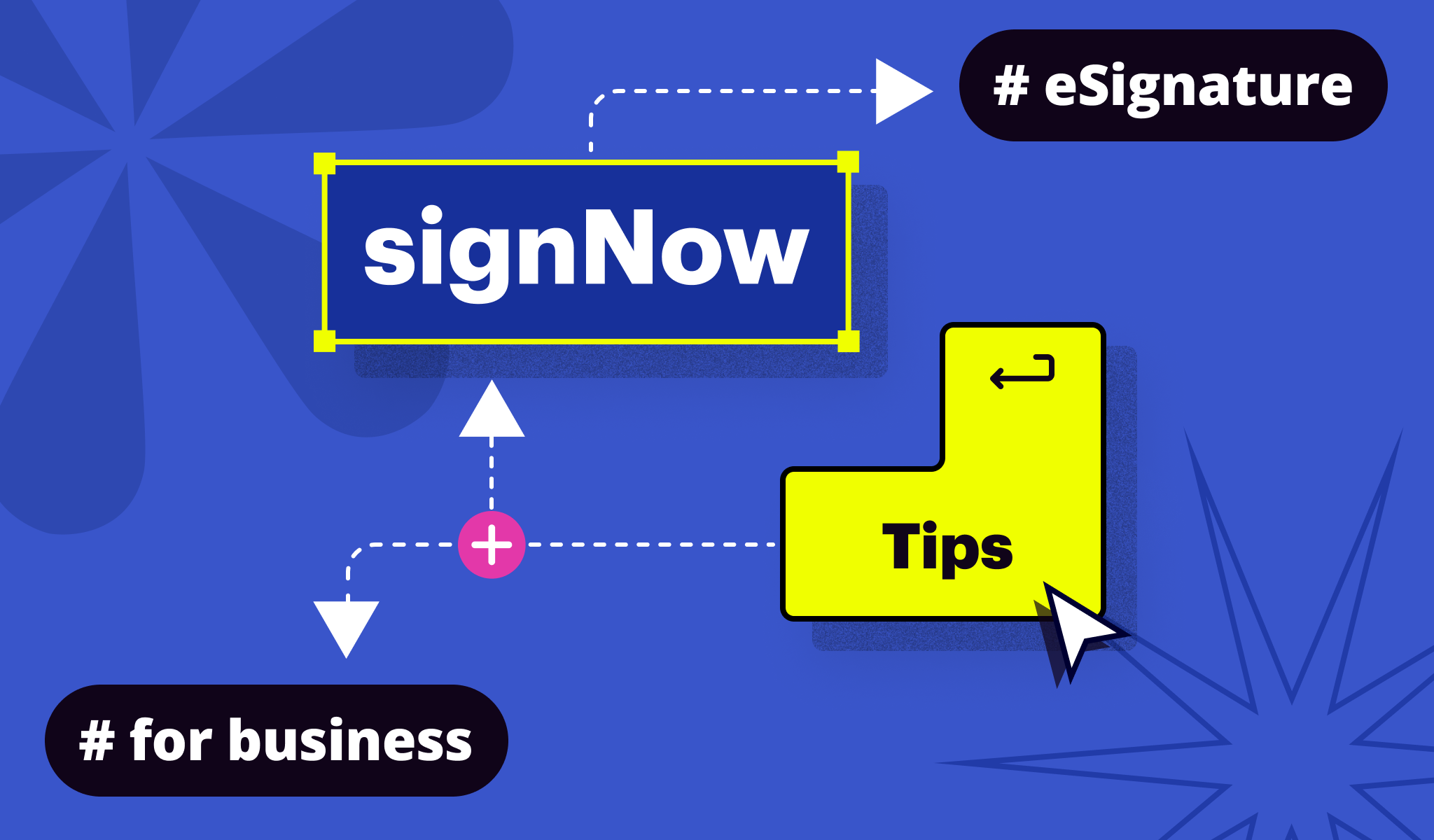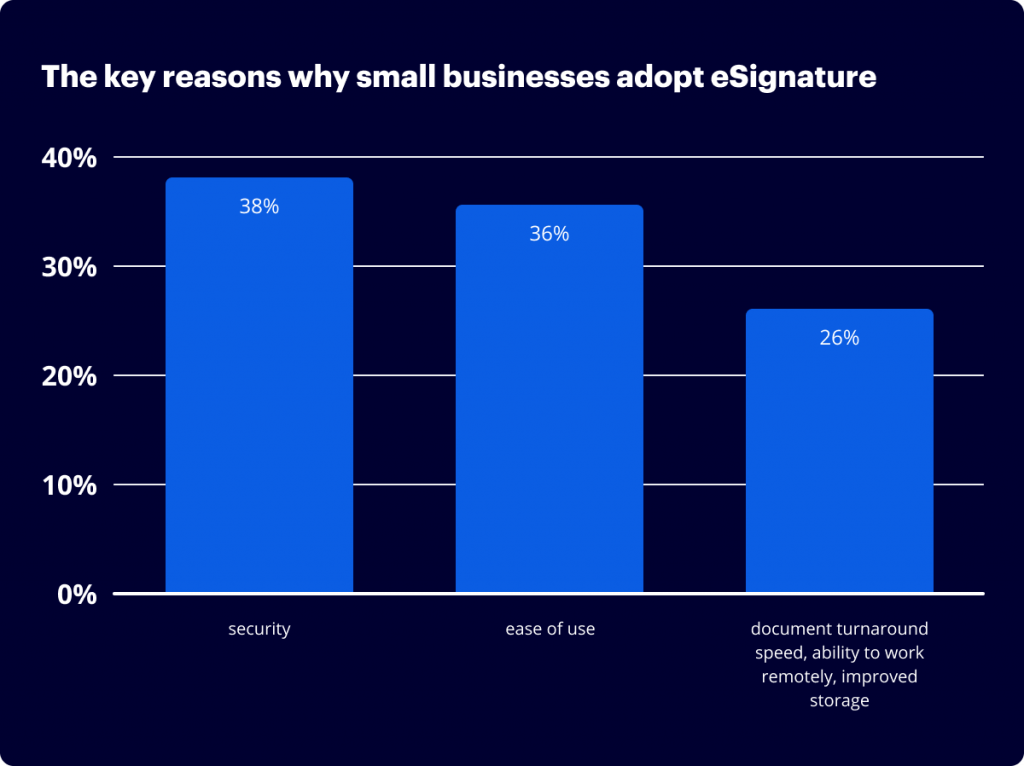
Along with remote operations, the ability to sign documents on the go and from anywhere has become the ‘new normal’. For many US businesses still hesitant to go back to the office, the new level of convenience and consistency that eSignature delivers to document processes has become the standard.
Not only do eSignatures offer a seamless way to put workflows on autopilot, but they also provide numerous benefits across different industries – education, finance, insurance, loans, and human resources, to name a few.
A recent Mediapeanut survey on technology growth reveals the reasons for the increase in eSignature adoption among small businesses: 38% of small business owners named security as the key reason for eSignature adoption, while 36% admitted they adopted an eSignature solution due to its ease of use. The remaining 26% deemed increased document turnaround speed, ability to work remotely, and improved storage as the key reasons for adopting eSignature.

By utilizing eSignature as part of a business cloud, you unlock new possibilities for streamlining your agreement processes at the stages of preparation, negotiation, signing, and can even improve agreement management. Now that organizations can integrate eSignatures into various business procedures, they have the benefit of using eSignature workflows as a major revenue driver for years to come.
In this blog, we’ll uncover how businesses can ensure smooth eSignature adoption in 2022. Let’s get started!
Why eSignatures are the ‘new normal’ for businesses
Throughout the pandemic, utilizing eSignatures became a necessity. From contracts and offer letters to invoicing and waivers, the demand for a more efficient signing process has greatly increased. It’s fair to say that eSignatures have transformed how US businesses operate by helping businesses that switched to a remote/hybrid mode of operations maintain resilience and continuity.
For many companies, making the switch to eSignatures meant flexible deployment options for meeting specific business requirements, without the need to involve strapped IT departments. Amidst the global health crisis, businesses didn’t have to worry about compliance and security issues since eSignature solutions like signNow ensured industry-leading compliance with security standards (SOC II, HIPAA, FERPA, and more).
Even though the adoption of electronic signature technology greatly accelerated due to the pandemic, businesses are realizing that more features do not always mean better. The adoption of eSignatures is projected to accelerate throughout the 2020s with more sophisticated software capabilities to come.

What are the benefits of eSignature for business?
Due to the widespread adoption of eSignatures, the pains associated with wet-ink signatures and issues that once surrounded the process of PDF and/or Word document signing have become a thing of the past. The adopters of eSignature enjoy an efficient way to request signatures which greatly improves internal compliance in business processes.
Quicker document turnaround and Audit Trails offered by modern eSignature solutions improve security and deliver ROI in the form of work hours and money saved. Not to mention the amount of physical storage freed up.
Just like with any other software, when choosing an eSignature solution, a business or enterprise should identify its key requirements. It is advised to determine eSignature use cases by reverse-engineering the requirements of your primary business strategy.
For example, organizations with a focus on B2B may have use cases surrounding the fulfillment of NDAs, sales and procurement, CPQ, and service agreements. Meanwhile, those who focus on B2C may have a higher priority for document management amongst client accounts – as well as forms, service terms, and applications.
By utilizing a SaaS-based eSignature as part of a workflow automation solution, businesses benefit from flexible deployment, support and maintenance, upgrade cycles, security and compliance.
Top 10 tips for small businesses to achieve a smooth eSignature adoption process
It often happens that using simple technology can transform the efficiency of company operations. That’s exactly the case with eSignatures as they provide an improved level of reliability and efficiency.
“Utilizing an eSignature solution like signNow has significantly improved our workflows at Mediapeanut… specifically for ensuring partnership agreements feel seamless for all parties involved”
– Paul Michael, Founder of Mediapeanut
A small business that plans to scale in the near future may want to onboard an eSignature solution by ensuring that legal, risk, and compliance requirements are met. To learn how eSignatures support your business workflows it’s worth understanding the adoption process as well as identifying the business needs.
Let’s explore the top 10 tips to allow for a smooth transition from wet-ink signatures to eSignature:
1. Define the reasons why you are adopting electronic signatures
Results can be seen shortly after onboarding an eSignature solution. The amount of free storage space and the ability to work anywhere is easy to check off the list, but you’ll want to further determine the business requirements for eSignature.
This can be achieved by focusing your attention on the areas where businesses commonly see improvements after transitioning to eSignature-based workflows: security, productivity, better performance, stakeholder experience, and faster document turnaround. The smooth adoption of eSignatures will likely impact several macro-level goals depending on the workflows you integrate them into.
2. Review the security benefits associated with the adoption of eSignature
Security is often touted by small businesses as the most obvious benefit of adopting an eSignature solution. It’s significantly more difficult to forge a signature electronically than using pen-and-paper. If your business requires network and server security supervision, understanding the required security and compliance standards (SOC II, HIPAA, FERPA, and others) will make choosing a solution easier.
3. Identify business requirements
Based on the macro-level strategy of your business, determining what your requirements are for reaching your overall goals can help a business reverse engineer which features are ideal in an electronic signature solution:
- If executing a business-to-business (B2B) strategy, then NDAs and service agreement workflows are likely a focus.
- If executing a Business to employee (B2E) strategy, then the requirements for onboarding as well as paperwork that surrounds employment should be reviewed.
- If executing a Business to consumer (B2C) strategy, then an eSignature workflow tailored to applications, service terms, and client accounts will be of interest.
4. Identify document control and tracking requirements
When there are multiple signers for a document it is important to confirm a reliable and predictable operations workflow. Based on the specific solution, the document management process will vary – the number of signatures and methods of signing can affect how exactly a small business approaches its document management.
The best eSignature solution will allow you to track the milestones of a document that requires signature(s). Additionally, the ability to adjust templates is something many small businesses may overlook when choosing the proper solution.

5. Know your legal requirements
A common obstacle for small businesses considering an electronic signature solution is the legal concerns that surround their processes. This is a very common reaction of team members when the discussion of transitioning smoothly to signing documents digitally is presented.
Team members will likely be relieved to hear that eSignature vendors have addressed the majority of these concerns globally. However, it’s worth educating yourself on the laws and regulations relevant to the specific industry and country your business operates in.
This will further your confidence in the eSignature solution you choose and help you define the one that’s compatible with your specific transactions and goals.
6. Gather feedback from your teams to support the adoption of eSignature
Depending on the size of your business, consulting with your security, fraud, and compliance teams should be a priority. Creating a blueprint of specific company use cases together with your team is a great way to satisfy and grow into the proper strategy when deciding on transitioning to signing digitally.
Team members will be pleased to hear that creating an electronic signature is not only faster than manual ink and paper, but your team will be able to track eSignatures in real time using a secure Audit Trail, automate email notifications, validate information, retain records and documents, as well as enjoy mobile signing.
You may also want to highlight the benefits of electronic signature adoption for your team. For example, those team members who don’t eSign documents very often in their day-to-day operations may not see the point in some eSignature capabilities such as tracking signatures in real time and mobile signing.
7. Determine if a workflow automation platform can better suit the use case
Should you choose a standalone eSignature solution or a workflow automation platform offering eSignature capabilities along with document workflow automation? This is another question that needs answering based on the spectrum of use cases. A workflow automation platform can adequately serve a range of use cases – whether it’s B2C, B2B, or even B2E. For instance, when it comes to B2E, a no-code document workflow automation solution can help human resources in a large enterprise to automate contract negotiation, employee onboarding, absence leave requests, and other typical HR workflows.
8. Determine if your industry has strict security and privacy regulations
An eSignature vendor will provide your business with the tools to tailor workflows to any specific situations and needs while still remaining compliant. However, compliance teams may be the first to utilize a new eSignature technology once it’s adopted.
If your business uses management software for compliance or regulatory reasons, then the right electronic signature tool should be the one that is easy to integrate. The most complex and regulated businesses, such as healthcare, where HIPAA and PHI compliance is required, utilize electronic signatures.
So, if there is any doubt of staying compliant while onboarding digital document signing for your business, you can rest assured the right eSignature solution likely exists.
9. Review the compatibility of the integration with your current stack of apps
When the topic of electronic signatures comes up in a business meeting, one of the first questions asked is “can eSignature integrate with our other software?”
Ensuring that an eSignature solution can integrate properly with your current small business tech stack is crucial. Most electronic signature solutions offer third-party integrations – for instance, signNow has over 200+ integrations with productivity apps, CRM systems, and payment gateways which makes it stand out among the competition.
A variety of integration options is often one of the best ways to ensure you get the most out of your transition to signing digitally. Even though it’s ideal to keep it simple in most scenarios, having the capability to connect your eSignature tool to other parts of your business may prove essential.
10. Determine how much time and money is currently spent on paper-based workflows
When transitioning to an electronic signature software, you will not only be saving money but gain the benefit of accelerated document turnaround. According to Lunar Pen, the traditional vs. eSignature time difference in obtaining signed documents is 5 days to 37 minutes! Meanwhile, Forrester suggests that using eSignature can potentially save businesses 22,000 hours annually.
One of the most overlooked benefits of eSignature is that it can reduce costs by accelerating time-to-revenue with faster document turnaround when compared to handwritten signatures. Not only will your business benefit from faster eSignature cycles, but your customers and suppliers also want a fast and secure way of signing documents as technology advances.
Ensuring a smooth eSignature transition
By eliminating pen and paper, both SMBs and enterprises will not only improve internal compliance, but reap the benefits in the form of increased security, faster document turnaround, tracking, and greater control over their document processes.
By getting electronic signatures in place, businesses can ensure that their signature process is secure and will help support current workflows. With a smooth transition to eSignature, businesses will gain the most impactful benefits that will allow them to compete in the present-day digital business environment.
Try signNow for SMBs & enterprises!
- Why eSignatures are the ‘new normal’ for businesses
- What are the benefits of eSignature for business?
- Top 10 tips for small businesses to achieve a smooth eSignature adoption process
- 1. Define the reasons why you are adopting electronic signatures
- 2. Review the security benefits associated with the adoption of eSignature
- 3. Identify business requirements
- 4. Identify document control and tracking requirements
- 5. Know your legal requirements
- 6. Gather feedback from your teams to support the adoption of eSignature
- 7. Determine if a workflow automation platform can better suit the use case
- 8. Determine if your industry has strict security and privacy regulations
- 9. Review the compatibility of the integration with your current stack of apps
- 10. Determine how much time and money is currently spent on paper-based workflows
- Ensuring a smooth eSignature transition

